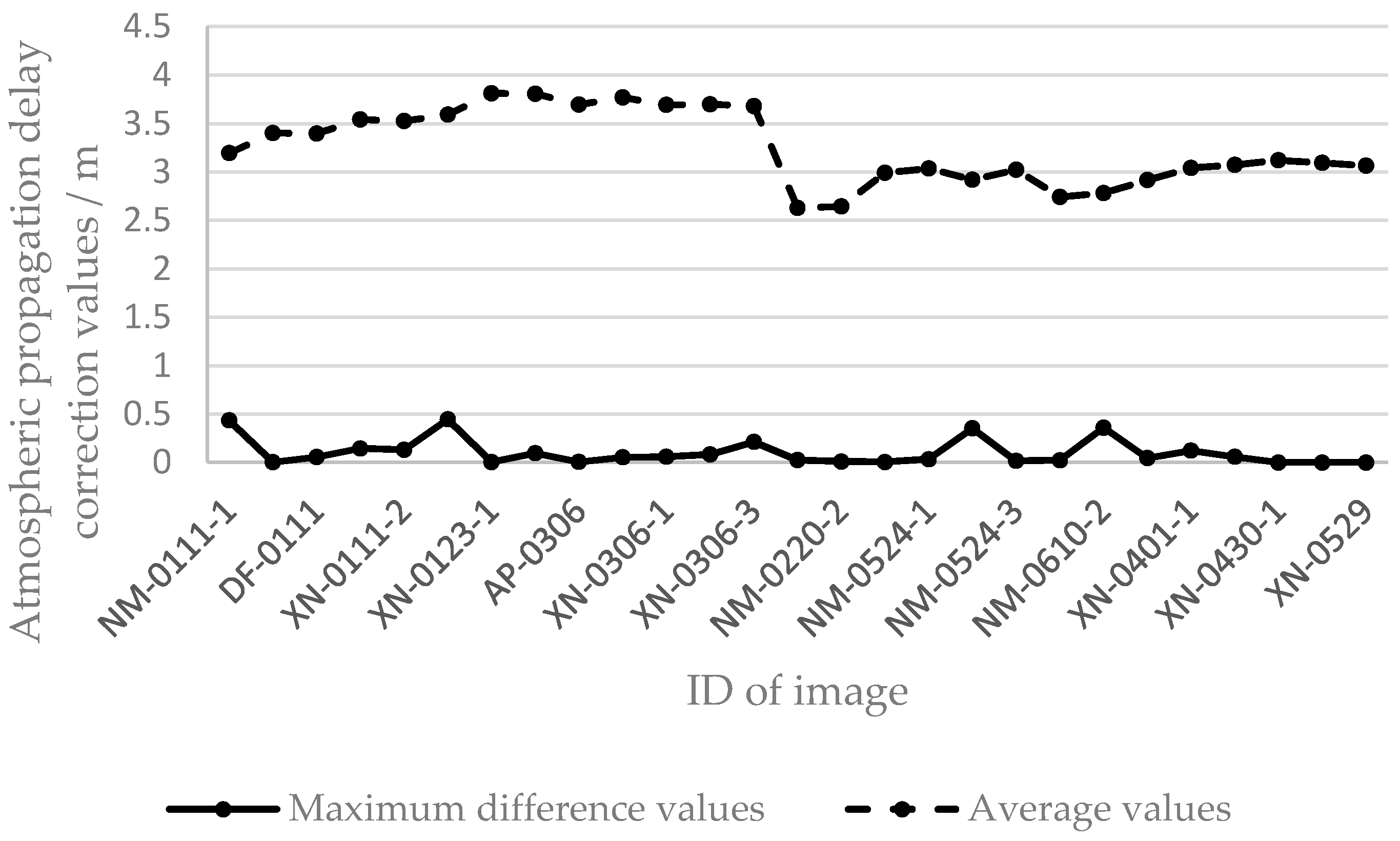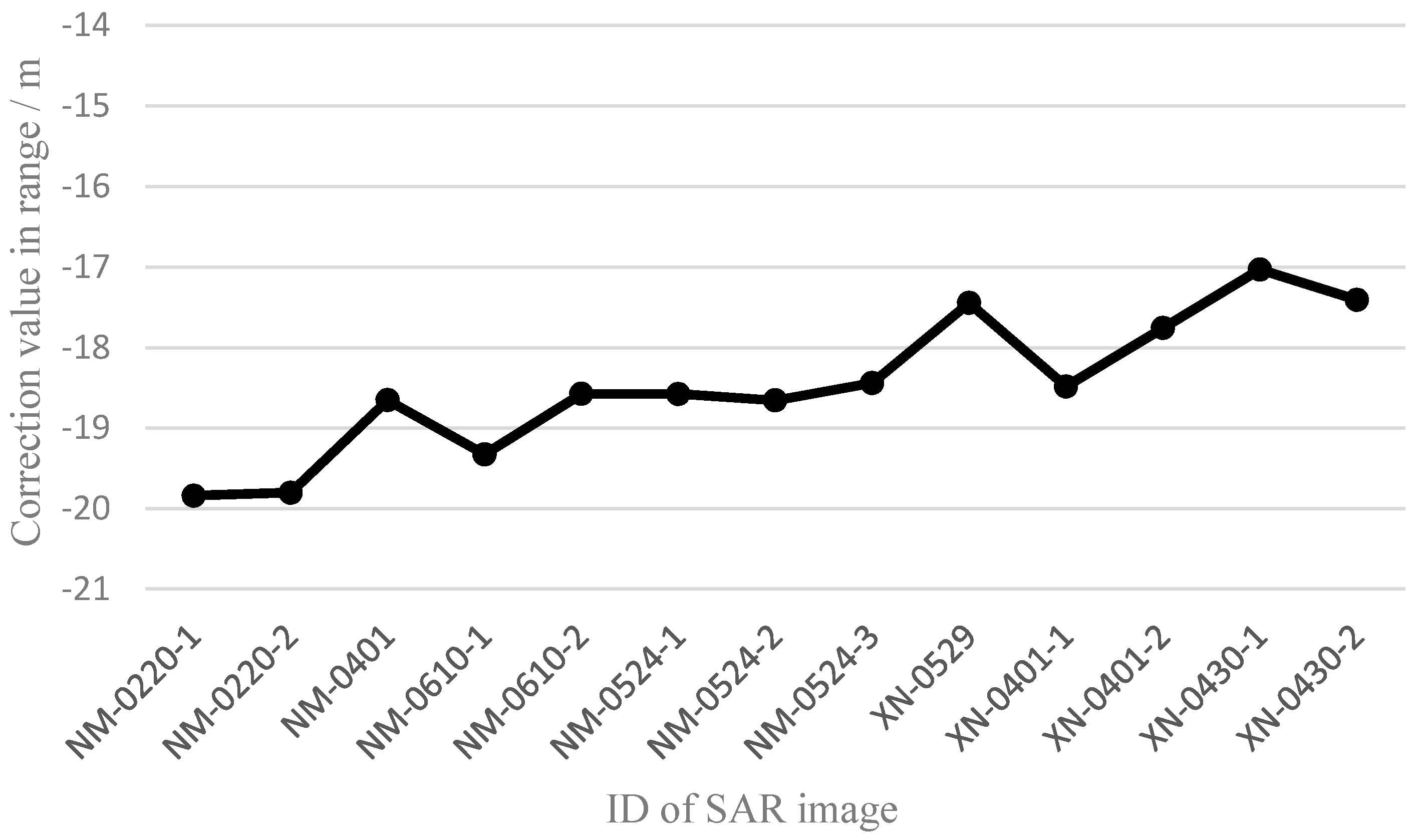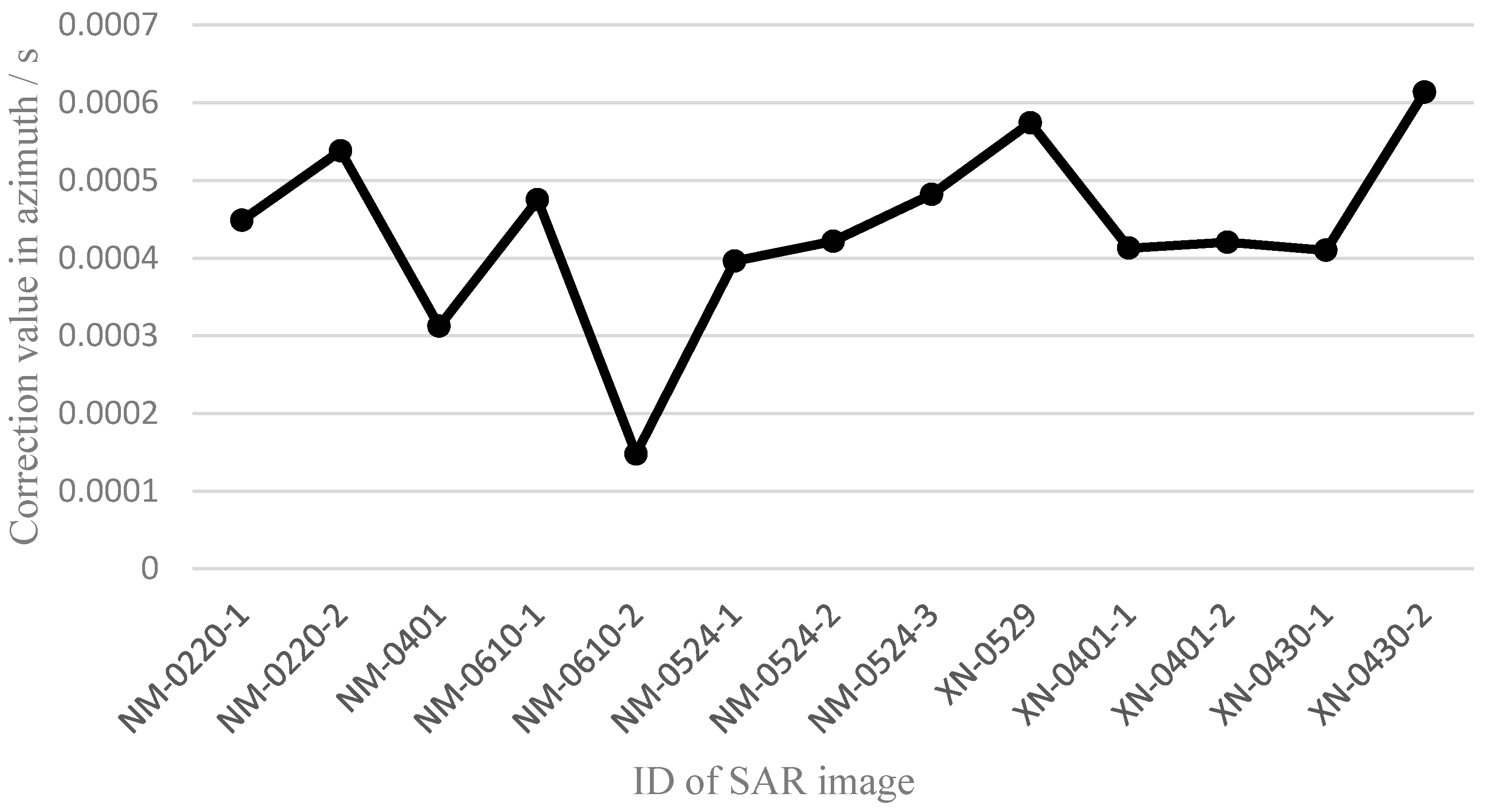Geometric Calibration and Accuracy Verification of the GF-3 Satellite
Abstract
:1. Introduction
2. GF-3 SAR System Description
3. Geometric Positioning Error Analysis for Spaceborne SAR
3.1. Fixed System Error
3.2. Time-Varying System Error
3.3. Random Error
4. Geometric Calibration and Accuracy Verification of Spaceborne SAR
5. Results and Discussion
5.1. Experimental Data
5.2. Experimental Results and Analysis
- (1)
- For a pulse-width and bandwidth of 24.99 μs and 50 MHz, and using Dengfeng city SAR image data as the calibration data, the system errors solved by the calibration data were corrected for the GF-3 satellite SAR image data in Tuoketuo country.
- (2)
- For a pulse-width and bandwidth of 30 μs and 50 MHz, and using Tuoketuo country SAR image data as the calibration data, the system errors solved by the calibration data were corrected for GF-3 satellite SAR image data in Xianning city.
- (3)
- For a pulse-width and bandwidth of 24.99 μs and 30 MHz, and using Xianning city SAR image data as the calibration data, the system errors solved by the calibration data were corrected for GF-3 satellite SAR image data in Anping country.
- (4)
- For a pulse-width and bandwidth of 24.99 μs and 40 MHz, and using Xianning city SAR image data as the calibration data, the system errors solved by the calibration data were corrected for GF-3 satellite SAR image data in Tuoketuo country and Dengfeng city.
6. Conclusions
Acknowledgments
Author Contributions
Conflicts of Interest
References
- Mohr, J.J.; Madsen, S.N. Geometric calibration of ERS satellite SAR images. IEEE Trans. Geosci. Remote Sens. 2001, 39, 842–850. [Google Scholar] [CrossRef] [Green Version]
- Arikawa, Y.; Suzuki, S. First result from ALOS-2 operation. In Proceedings of the Earth Observing Missions and Sensors: Development, Implementation, and Characterization III, Beijing, China, 19 November 2014; pp. 8691–8694. [Google Scholar]
- Williams, D.; Ledantec, P.; Chabot, M.; Hillman, A.; James, K.; Caves, R.; Thompson, A.; Vigneron, C.; Wu, Y. RADARSAT-2 Image Quality and Calibration Update. In Proceedings of the EUSAR 2014: 10th European Conference on Synthetic Aperture Radar, Berlin, Germany, 3–5 June 2014. [Google Scholar]
- Brautigam, B.; Schwerdt, M.; Bachmann, M.; Doring, B. Results from geometric and radiometric calibration of TerraSAR-X. In Proceedings of the 2007 European Radar Conference, Munich, Germany, 10–12 October 2007; pp. 87–90. [Google Scholar]
- Schwerdt, M.; Brautigam, B.; Bachmann, M.; Doring, B.; Schrank, D.; Gonzalez, H.G. Final results of the efficient TerraSAR-X calibration method. In Proceedings of the IEEE Radar Conference, Rome, Italy, 26–30 May 2008; Volume 6805, pp. 1–6. [Google Scholar]
- Fritz, T.; Breit, H.; Schättler, B.; Lachaise, M.; Balss, U.; Eineder, M. TerraSAR-X Image Products: Characterization and Verification. In Proceedings of the 7th European Conference on Synthetic Aperture Radar (EUSAR), Friedrichshafen, Germany, 2–5 June 2008. [Google Scholar]
- Schwerdt, M.; Schmidt, K.; Tous Ramon, N.; Zink, M. Independent Verification of the Sentinel-1A System Calibration. IEEE J. Sel. Top. Appl. Earth Obs. Remote Sens. 2013, 2015, 1097–1100. [Google Scholar]
- Schubert, A.; Small, D.; Miranda, N.; Meier, E. Sentinel-1A Product Geolocation Accuracy: Commissioning Phase Results. Remote Sens. 2015, 7, 9431–9449. [Google Scholar] [CrossRef]
- Ding, C.; Liu, J.; Lei, B.; Qiu, X. Preliminary exploration of systematic geolocation accuracy of GF-3 SAR satellite system. J. Radars 2017, 6, 11–16. [Google Scholar]
- Zhang, Q. System design and key technologies of the GF-3 satellite. Acta Geod. Cartogr. Sin. 2017, 46, 269–277. [Google Scholar]
- Zhao, R.; Zhang, G.; Deng, M.; Yang, F.; Chen, Z.; Zheng, Y. Multimode Hybrid Geometric Calibration of Spaceborne SAR Considering Atmospheric Propagation Delay. Remote Sens. 2017, 9, 464. [Google Scholar] [CrossRef]
- Qiu, X.; Han, C.; Liu, J. A method for spaceborne SAR geolocation based on continuously moving geometry. J. Radars. 2013, 2, 54–59. [Google Scholar] [CrossRef]
- Curlander, J.C. Location of spaceborne SAR imagery. Geoscience and Remote Sensing. IEEE Trans. Geosci. Remote Sens. 1982, 3, 359–364. [Google Scholar] [CrossRef]
- Roth, A.; Craubner, H.; Bayer, T. Prototype SAR Geocoding algorithms for ERS-1 and SIR-C/X-SAR Images. In Proceedings of the 12th International Canadian Symposium on Remote Sensing Geoscience and Remote Sensing Symposium (IGARSS’89), Vancouver, BC, Canada, 10–14 July 1989; pp. 604–607. [Google Scholar]
- Schreier, G.; Raggam, J.; Strobl, D. Parameters for Geometric Fidelity of Geocoded SAR Products. In Proceedings of the 10th Annual International Geoscience and Remote Sensing Symposium: Remote Sensing Science for the Nineties (IGARSS’90), College Park, MA, USA, 20–24 May 1990. [Google Scholar]
- Yan, L.; Li, M. Accuracy analysis of Chebyshev polynomial to fit satellite orbit and clock error. Sci. Surv. Mapp. 2013, 3, 59–62. [Google Scholar]
- Fang, S.; Du, L.; Zhou, P.; Lu, Y.; Zhang, Z.; Liu, Z. Orbital list ephemerides design of LEO navigation augmentation satellite. Acta Geod. Cartogr. Sin. 2016, 8, 904–910. [Google Scholar]
- McCarthy, D.D.; Petit, G. IERS Conventions, 2003. In IERS Technical Note 32; Verlag des Bundesamtes für Kartographie und Geodäsie: Frankfurt am Main, Germany, 2004. [Google Scholar]
- Milbert, D. Solid.exe Program. Available online: http://home.comcast.net/~dmilbert/softs/solid.htm#link6 (accessed on 10 February 2017).
- Ghavidel, A.; Schiavulli, D.; Camps, A. A numerical simulator to evaluate the electromagnetic bias in GNSS-R altimetry. In Proceedings of the 2014 IEEE International Geoscience and Remote Sensing Symposium (IGARSS), Quebec City, QC, Canada, 13–18 July 2014; pp. 4066–4069. [Google Scholar]
- Ghavidel, A.; Camps, A. Time-domain statistics of the electromagnetic bias in GNSS-reflectometry. Remote Sens. 2015, 7, 11151–11162. [Google Scholar] [CrossRef] [Green Version]





| Imaging Mode | Incidence Angle (°) | Resolution (m) | Imaging Width (km) | Polarization Mode |
|---|---|---|---|---|
| Spotlight (SL) | 20–50 | 1 | 10 | Selective single-polarization |
| Ultra-fine stripmap (UFSM) | 20–50 | 3 | 30 | Selective single-polarization |
| Fine stripmap 1 (FSM_I) | 19–50 | 5 | 50 | Selective dual-polarization |
| Fine stripmap 2 (FSM_II) | 19–50 | 10 | 100 | Selective dual-polarization |
| Standard stripmap (SSM) | 17–50 | 25 | 130 | Selective dual-polarization |
| Narrow scan SAR (NSC) | 17–50 | 50 | 300 | Selective dual-polarization |
| Wide scan SAR (WSC) | 17–50 | 100 | 500 | Selective dual-polarization |
| Global observation mode (GLO) | 17–53 | 500 | 650 | Selective dual-polarization |
| Full polarization stripmap 1 (FPSM_I) | 20–41 | 8 | 30 | Full polarization |
| Full polarization stripmap 2 (FPSM_II) | 20–38 | 25 | 40 | Full polarization |
| Wave mode (WAV) | 20–41 | 10 | 5 | Full polarization |
| Extended mode (EXT) | 10–20 | 25 | 130 | Selective dual-polarization |
| 50–60 | 25 | 80 | Selective dual-polarization |
| Imaging Mode | Pulse-Width and Bandwidth | Date of Imaging | Imaging Region | Number of Images | ID of Image | Number of GCPs |
|---|---|---|---|---|---|---|
| FSM_I (5 m resolution) | 24.99 μs and 50 MHz | 11 January 2017 | Tuoketuo country | 2 | NM-0111-1 | 8 |
| NM-0111-2 | 2 | |||||
| 11 January 2017 | Dengfeng City | 1 | DF-0111 | 3 | ||
| 11 January 2017 | Xianning city | 2 | XN-0111-1 | 14 | ||
| XN-0111-2 | 7 | |||||
| 30 μs and 50 MHz | 23 January 2017 | Tuoketuo country | 1 | NM-0123 | 5 | |
| 23 January 2017 | Xianning city | 2 | XN-0123-1 | 2 | ||
| XN-0123-2 | 11 | |||||
| FPSM_I (8 m resolution) | 24.99 μs and 30 MHz | 6 March 2017 | Anping County | 1 | AP-0306 | 2 |
| 10 March 2017 | Xianning city | 1 | XN-0310 | 3 | ||
| 6 March 2017 | Xianning city | 3 | XN-0306-1 | 5 | ||
| XN-0306-2 | 8 | |||||
| XN-0306-3 | 6 | |||||
| 24.99 μs and 40 MHz | 20 February 2017 | Tuoketuo country | 2 | NM-0220-1 | 4 | |
| NM-0220-2 | 2 | |||||
| 1 April 2017 | Tuoketuo country | 1 | NM-0401 | 3 | ||
| 24 May 2017 | Tuoketuo country | 3 | NM-0524-1 | 3 | ||
| NM-0524-2 | 11 | |||||
| NM-0524-3 | 3 | |||||
| 10 June 2017 | Tuoketuo country | 2 | NM-0610-1 | 5 | ||
| NM-0610-2 | 6 | |||||
| 1 April 2017 | Dengfeng City | 1 | DF-0401 | 2 | ||
| 1 April 2017 | Xianning city | 2 | XN-0401-1 | 7 | ||
| XN-0401-2 | 4 | |||||
| 30 April 2017 | Xianning city | 2 | XN-0430-1 | 1 | ||
| XN-0430-2 | 1 | |||||
| 29 May 2017 | Xianning city | 1 | XN-0529 | 1 |
| Imaging Mode | Pulse-Width and Bandwidth | ID of Image | Line (Pixel) | Sample (Pixel) | 2-D (Pixel) |
|---|---|---|---|---|---|
| FSM_I (5 m resolution) | 24.99 μs and 50 MHz | NM-0111-1 | 0.122 | 0.308 | 0.331 |
| NM-0111-2 | 0.091 | 0.179 | 0.201 | ||
| DF-0111 | 0.014 | 0.168 | 0.169 | ||
| XN-0111-1 | 0.121 | 0.353 | 0.373 | ||
| XN-0111-2 | 0.07 | 0.332 | 0.339 | ||
| 30 μs and 50 MHz | NM-0123 | 0.114 | 0.17 | 0.205 | |
| XN-0123-1 | 0.052 | 0.216 | 0.222 | ||
| XN-0123-2 | 0.189 | 0.437 | 0.476 | ||
| FPSM_I (8 m resolution) | 24.99 μs and 30 MHz | AP-0306 | 0.118 | 0.071 | 0.138 |
| XN-0310 | 0.079 | 0.359 | 0.367 | ||
| XN-0306-1 | 0.116 | 0.346 | 0.365 | ||
| XN-0306-2 | 0.15 | 0.192 | 0.243 | ||
| XN-0306-3 | 0.163 | 0.221 | 0.275 | ||
| 24.99 μs and 40 MHz | NM-0220-1 | 0.064 | 0.253 | 0.261 | |
| NM-0220-2 | 0.175 | 0.013 | 0.176 | ||
| NM-0401 | 0.343 | 0.102 | 0.358 | ||
| NM-0524-1 | 0.025 | 0.156 | 0.157 | ||
| NM-0524-2 | 0.086 | 0.233 | 0.249 | ||
| NM-0524-3 | 0.115 | 0.103 | 0.155 | ||
| NM-0610-1 | 0.086 | 0.24 | 0.255 | ||
| NM-0610-2 | 0.14 | 0.21 | 0.253 | ||
| DF-0401 | 0.073 | 0.008 | 0.074 | ||
| XN-0401-1 | 0.118 | 0.186 | 0.22 | ||
| XN-0401-2 | 0.144 | 0.36 | 0.388 | ||
| XN-0430-1 | 0 | 0 | 0 | ||
| XN-0430-2 | 0 | 0 | 0 | ||
| XN-0529 | 0 | 0 | 0 |
| Imaging Mode | Pulse-Width and Bandwidth | ID of Image | Geometric Calibration | Azimuth (Pixel) | Range (Pixel) | 2-D | |
|---|---|---|---|---|---|---|---|
| (Pixel) | (m) | ||||||
| FSM_I (5 m resolution) | 24.99 μs and 50 MHz | NM-0111-1 | Before | 0.463 | 9.679 | 9.690 | 21.802 |
| after | 0.176 | 1.217 | 1.230 | 2.781 | |||
| NM-0111-2 | Before | 0.528 | 9.840 | 9.854 | 22.175 | ||
| after | 0.106 | 1.121 | 1.126 | 2.537 | |||
| 30 μs and 50 MHz | XN-0123-1 | Before | 0.432 | 10.452 | 10.461 | 23.540 | |
| after | 0.301 | 0.505 | 0.588 | 1.481 | |||
| XN-0123-2 | Before | 0.525 | 9.940 | 9.954 | 22.412 | ||
| after | 0.301 | 0.441 | 0.534 | 1.374 | |||
| QPSM_I (8 m resolution) | 24.99 μs and 30 MHz | AP-0306 | Before | 0.655 | 5.211 | 5.252 | 23.663 |
| after | 0.136 | 0.264 | 0.296 | 1.366 | |||
| 24.99 μs and 40 MHz | NM-0220-1 | Before | 0.549 | 9.997 | 10.013 | 22.686 | |
| after | 0.079 | 1.018 | 1.021 | 2.330 | |||
| NM-0220-2 | Before | 0.677 | 9.983 | 10.007 | 22.763 | ||
| after | 0.186 | 0.969 | 0.986 | 2.413 | |||
| NM-0401 | Before | 0.531 | 9.628 | 9.643 | 21.824 | ||
| after | 0.410 | 0.469 | 0.623 | 2.379 | |||
| NM-0524-1 | Before | 0.482 | 9.613 | 9.625 | 21.778 | ||
| after | 0.112 | 0.451 | 0.465 | 1.190 | |||
| NM-0524-2 | Before | 0.520 | 9.599 | 9.613 | 21.774 | ||
| after | 0.116 | 0.515 | 0.528 | 1.324 | |||
| NM-0524-3 | Before | 0.597 | 9.546 | 9.564 | 21.717 | ||
| after | 0.115 | 0.377 | 0.394 | 1.061 | |||
| NM-0610-1 | Before | 0.584 | 9.817 | 9.834 | 22.208 | ||
| after | 0.088 | 0.794 | 0.799 | 1.850 | |||
| NM-0610-2 | Before | 0.228 | 9.507 | 9.510 | 21.413 | ||
| after | 0.435 | 0.473 | 0.642 | 2.632 | |||
© 2017 by the authors. Licensee MDPI, Basel, Switzerland. This article is an open access article distributed under the terms and conditions of the Creative Commons Attribution (CC BY) license (http://creativecommons.org/licenses/by/4.0/).
Share and Cite
Zhao, R.; Zhang, G.; Deng, M.; Xu, K.; Guo, F. Geometric Calibration and Accuracy Verification of the GF-3 Satellite. Sensors 2017, 17, 1977. https://doi.org/10.3390/s17091977
Zhao R, Zhang G, Deng M, Xu K, Guo F. Geometric Calibration and Accuracy Verification of the GF-3 Satellite. Sensors. 2017; 17(9):1977. https://doi.org/10.3390/s17091977
Chicago/Turabian StyleZhao, Ruishan, Guo Zhang, Mingjun Deng, Kai Xu, and Fengcheng Guo. 2017. "Geometric Calibration and Accuracy Verification of the GF-3 Satellite" Sensors 17, no. 9: 1977. https://doi.org/10.3390/s17091977





